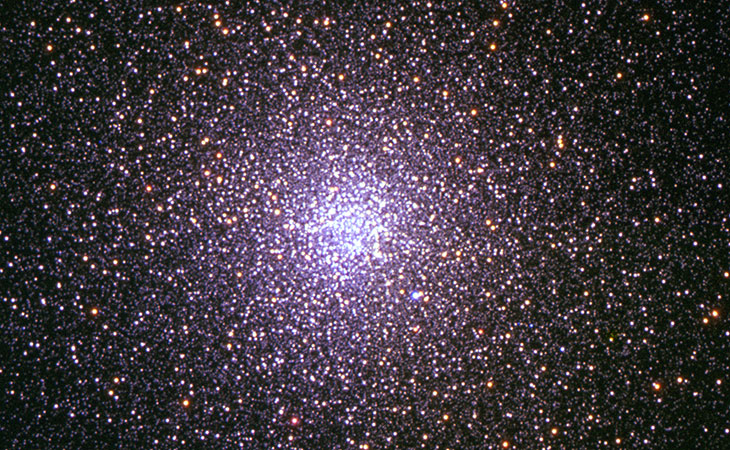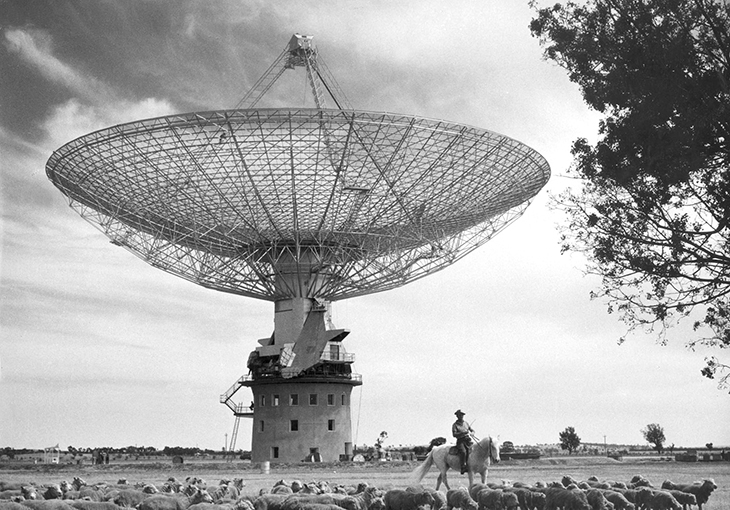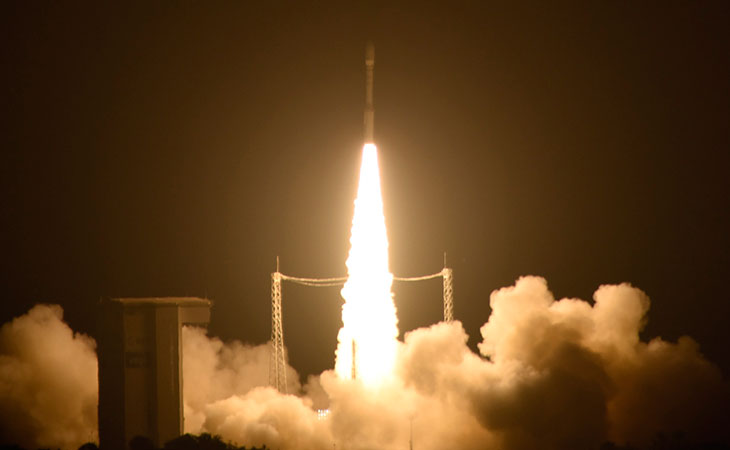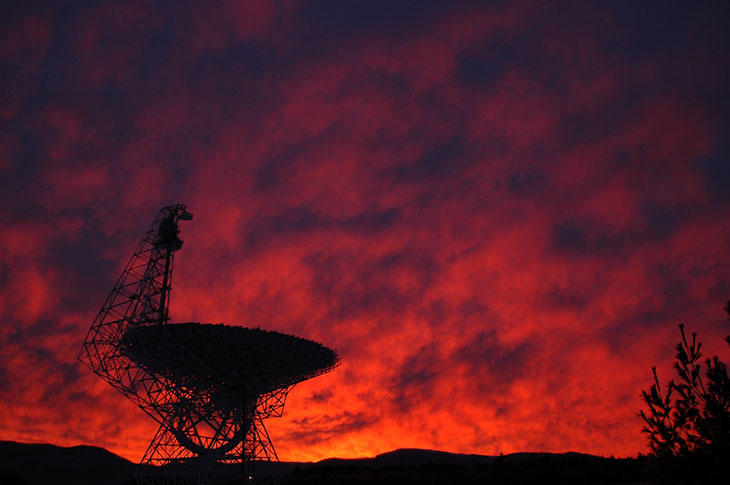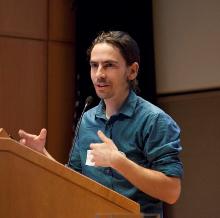For Some, Einstein's Space-Time Ripples Have Yet To Break Their Silence
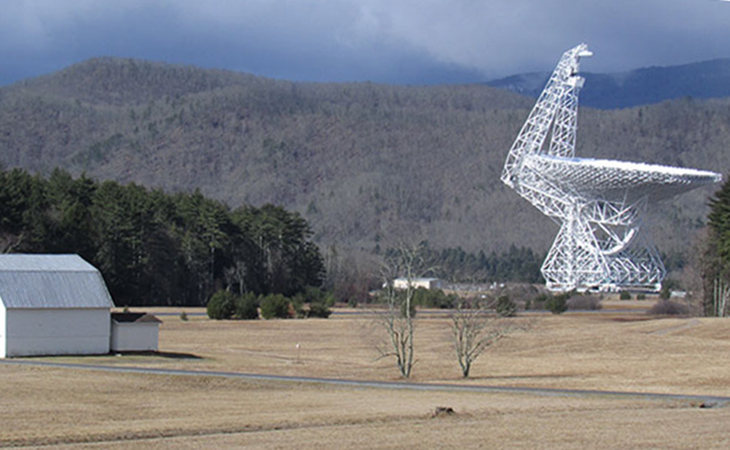
The Green Bank Telescope in West Virginia
Gabriel Popkin
(Inside Science) -- When leaders of the Laser Interferometer Gravitational-wave Observatory, or LIGO, announced in February the first-ever direct detection of a gravitational wave, astrophysicists Scott Ransom from the National Radio Astronomy Observatory and Andrea Lommen at Franklin and Marshall University in Lancaster, Pennsylvania, had mixed feelings.
On the one hand, it meant that the team they and others lead, which searches for gravitational waves using radio telescopes aimed at special stars called pulsars, would not score the first detection. "We loved the idea of being kind of a dark horse," Ransom admitted.
On the other hand, they were thrilled for their colleagues at LIGO—and for gravitational wave astronomy. "I was really excited, for a whole day I think, before I got jealous," said Lommen. "We've all been working in this field that's had no detections for 20, 30 years—and now we have a detection. People can no longer make fun of us."
Above all, Ransom, Lommen and their colleagues hope that, like a rising tide, the excitement around the finding will boost all gravitational wave research—including their own.
The field needs the validation. Radio telescopes and planned space-based gravitational wave observatories have taken major budget hits in the past few years, and what looked like a 2014 finding of gravitational waves from the Big Bang turned out to be mere dust. By contrast, LIGO's success, which seems almost certain to stand, promises to be just the beginning of the era of gravitational wave astronomy, in which several types of instruments start to answer critical questions about the waves—and the objects that produce them.
But LIGO can't do it alone. According to Einstein's theory of general relativity and astronomers' observations over the past century, the universe should be full of gravitational waves of many strengths and frequencies. LIGO, however, can detect only high-frequency waves like those it captured on September 14, 2015 from the final moments when two black holes merged into one.
That's where three other ways to detect gravitational waves -- tracking of pulsars, laser interferometry in space and studies of radiation from the early universe—come in. Just as telescopes, which can now see in radio, infrared, ultraviolet, and X-rays in addition to visible light, continue to reveal new things about our universe, only with all four detection methods will astronomers gain access to all the information gravitational waves can provide. As Gabriela Gonzalez, a physicist at Louisiana State University in Baton Rouge, and spokesperson for the LIGO collaboration, put it at the February 11 press conference announcing the initial finding, "I want to see all these windows open as soon as possible."
Listening to pulsars
Albert Einstein predicted the existence of gravitational waves in 1916, a year after he published the theory of general relativity. But because even a strong gravitational wave would have only tiny effects on Earth—jiggling objects by far less than the size of a proton—Einstein despaired at ever detecting one experimentally.
By the early 1980s, however, the hunt was on. While the National Science Foundation was funding the first studies that eventually led to LIGO, researchers were already thinking up other ways to detect gravity's tiny ripples. One involved studying the signals from fast-rotating stars called pulsars. Pulsars form when a star at least 8 times the mass of the sun explodes as a supernova, and its remaining mass collapses into a dense, spinning sphere of neutrons. These neutron stars become magnetized and send out electromagnetic radiation, often in the form of radio waves, making them massive cosmic lighthouses. If a pulsar is close enough and its pulses happen to sweep over Earth, modern telescopes can detect them.
In the late 1970s and early 1980s, changes in the timing of signals from a pulsar orbiting another neutron star provided indirect evidence for gravitational waves' existence, leading to the 1993 Nobel Prize in Physics. Then, in 1982, astrophysicist Donald Backer at the University of California, Berkeley proposed that scientists could use certain, fast-spinning "millisecond pulsars" for a more direct detection, by measuring tiny differences in the pulses' arrival times at Earth as passing gravitational waves lightly nudge the planet toward some pulsars and away from others.
The "pulsar timing array" Backer envisioned would be like a galactic-scale spider web, in which Earth sits in the middle, and is connected to each pulsar by a strand. The more strands there are, the more easily scientists could tell when Earth has shifted slightly.
In particular, Backer thought pulsars could be used to detect gravitational waves that scientists believe are constantly emanating from enormous, galaxy-sized black holes—objects millions or billions times as massive as the black holes LIGO detected -- that orbit each other in the distant universe. Because such pairs take years to complete a turn, the waves they send out are extremely low-frequency and monstrously long—light-years in wavelength.
The effect Backer proposed to measure was much larger than what LIGO detected, but still exceptionally small in everyday terms—about one part in the number 10 followed by 16 zeroes—and scientists would still need years of pulsar measurements before they could be sure they had a true detection. It would also require finding and tracking far more millisecond pulsars than astronomers knew of at the time Backer proposed the experiment. "Millisecond pulsars and LIGO and some quantum experiments are by far some of most precise physics experiments that you can do," said Ransom.
Building detection networks
In 2004, astrophysicist Richard Manchester of the Commonwealth Scientific and Industrial Research Organisation (CSIRO) in Australia launched an effort to find and track the timing of pulsars in the Southern Hemisphere using the 64-meter-diameter Parkes radio telescope. At that point, Ransom, Lommen and Fredrick Jenet, a physicist at the University of Texas at Brownsville, initiated discussions that led to what they called the North American Nanohertz Observatory for Gravitational Waves or NANOGrav. "We saw that there was international competition," said Ransom. "That's when things got really serious."
The NANOGrav team now uses the 100-meter Green Bank Telescope in West Virginia and the 300-meter Arecibo telescope in Puerto Rico—currently the world's two most powerful radio telescopes—to track 54 millisecond pulsars and search for new ones. The enormous dishes are needed to reflect enough of the pulsars' extremely faint radio waves up to a receiver that captures the signal—pulses as regular as ticks of the most precise Earthbound clocks.
The Australian team, meanwhile, tracks 24 pulsars, and last summer published in Science an analysis of more than a decade of data from their four most regular pulsars. They found no evidence for gravitational waves, even though many theoretical models predicted that gravitational-wave-producing pairs of supermassive black holes would form frequently enough that the Parkes team should have detected them. Based on their analysis, the researchers suggested that the pulsar timing community might have to wait a few years until the Square Kilometer Array, a planned massive radio telescope array in Australia and South Africa, begins operating before they have a good chance of a detection.
But NANOGrav countered that there is much scientists still don't know about how often supermassive black hole pairs form, and that the Parkes team had ruled out only overly optimistic models. In a paper published last month in Astrophysical Journal Letters, NANOGrav members made a case for adding more pulsars to their array to increase sensitivity, predicting a detection within a decade if they stay the course.
NANOGrav, the Parkes Pulsar Timing Array, and a European pulsar timing team have also agreed to share data as an International Pulsar Timing Array, or IPTA, which should help scientists improve their understanding of the rate of supermassive black hole mergers even more.
"This is first time that pulsar timing arrays have actually been able to do real astrophysics," said Ransom. "That's really exciting for us."
The group is preparing its second data release for later this year, and that should put the earlier disagreement behind them, said George Hobbs, astrophysicist at CSIRO and current director of the Parkes team. "Suddenly the IPTA becomes most important thing, and that's what we all want to see happening."
Filling in the spectrum
Around the same time dreams of LIGO and pulsar timing arrays were taking shape, researchers began proposing a LIGO-like experiment that would put the detector in space. The advantages over a ground-based detector were many—the "arms" could be millions of kilometers long, instead of just a few kilometers, and noise from Earthly events like falling trees and breaking ocean waves (both of which impact LIGO) would be eliminated—making such a detector potentially sensitive to far more gravitational waves.
The idea took shape as a joint NASA-European Space Agency project called the Laser Interferometer Space Antenna, or LISA, and was to have launched this decade. But NASA pulled out of the project in 2012, citing cost. ESA retooled the project as evolved LISA, or eLISA, whose arms will reach 1 million kilometers. Though eLISA now has a projected launch date of 2034, ESA in December launched its LISA Pathfinder mission, which aims to prove the technology needed for eLISA.
China is also currently considering launching its own detector or partnering with the European effort. Either choice could shorten the time to a detection, scientists say.
A fourth method for seeking gravitational waves received a burst of attention on March 17, 2014, when physicists at Harvard and several other institutions announced they had used the BICEP2 telescope at the South Pole to detect the imprint of gravitational waves on the cosmic microwave background, which is the faint, leftover light from when hydrogen atoms first formed after the Big Bang, and which marks the edge of the observable universe.
Many leading theories of cosmic birth suggest that the universe ballooned rapidly just after the Big Bang, during a period known as "inflation." This violent growth spurt, occurring when all mass was packed into a tiny volume, would have released immense gravitational waves. Some 380,000 years later, these waves, now stretched out to millions or billions of light-years, would have interacted with the cosmic microwave background in a particular way that could be detected.
Such a tantalizing prediction has inspired numerous research groups to design microwave telescopes to look for this signature. The BICEP2 group, in conjunction with leaders of ESA's Planck satellite, eventually declared their findings inconclusive after others pointed out that dust in the Milky Way could produce the same signal they were interpreting as polarization of the cosmic microwave background.
Still, new telescopes are joining the search for primordial gravitational waves. One of the most powerful of these is the Cosmology Large Angular Scale Surveyor, or CLASS, now being built in northern Chile's Atacama Desert. CLASS will take measurements at multiple wavelengths needed to distinguish background radiation from signals emitted by dust and other nearby sources, and will survey a large swath of the sky to capture the most complete information. The experiment requires a sophisticated detection system cooled to close to absolute zero, stretching the limits of existing technology.
"Once we decided to measure the large scales, then the question was what you do need to do it, and even if it's hard, that's what needs to be done," said Charles Bennett, a Johns Hopkins University cosmologist who is leading the CLASS project. Bennett hopes for first light for CLASS later this year.
Funding the future
In addition to peering at the sky, gravitational wave hunters must keep an eye on Washington, and recent messages from that direction have been mixed. Pulsar timing got a big boost in 2015, when the National Science Foundation awarded NANOGrav a five-year, $14.5-million grant.
At the same time, however, NSF is looking to unload the telescopes that NANOGrav relies on. A review committee recommended in 2012 that NSF, which has been the primary supporter of Arecibo and Green Bank, divest from the Green Bank Telescope, and consider divesting from Arecibo, in favor of other facilities.
For now, NSF continues to partly fund the telescopes, while other efforts like Russian billionaire Yuri Milner's Breakthrough Listen project, which will search for radio emissions from extraterrestrial civilizations, fill in the gap. But the telescopes' long-term futures are uncertain—not because they don't do good science, but because there is simply not enough money to fund all worthy projects, explained James Ulvestad, director of NSF's astronomy division. The 2012 review specifically highlighted the Green Bank Telescope's contributions to NANOGrav, he said, but "that alone was not enough to put the Green Bank Telescope on the top of our priority list."
The loss of either telescope would delay a gravitational wave detection by years, experts say, at least until a mammoth 500-meter dish under construction in China comes online later this decade.
"At this moment in history … when we're just opening up the gravitational wave era of physics," said Lommen, "it's a shame to talk about closing either of those telescopes, because they make such a difference."
Ransom thinks LIGO's—and other—recent successes could reinvigorate the field and help keep the telescopes open. "I hope I'm not just being optimistic," he said. "We're actually doing real astrophysics and having upper limits that actually matter and change models and change people's thinking.
"Gravitational waves are becoming relevant to astronomy."

